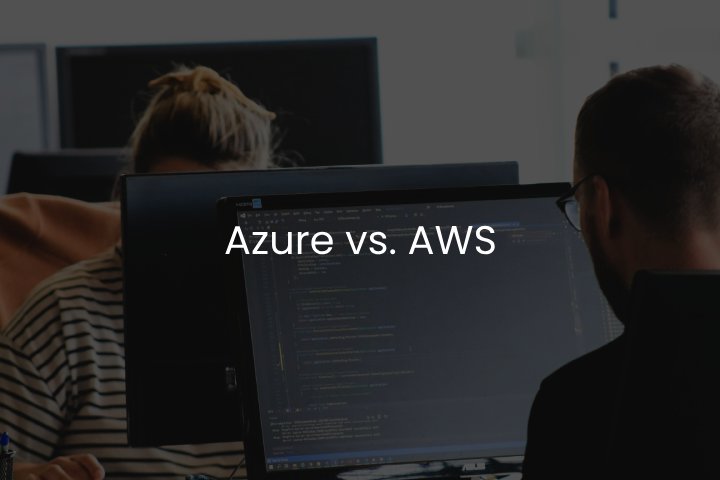
Cloud Services from a Technical Standpoint: Azure vs. AWS
Azure and AWS are well-known cloud service providers that are functionally identical in most use cases. Companies choose cloud service providers depending on demands and requirements, and Azure and AWS each offer many different capabilities. For instance, Azure would be the greatest choice if a business needs a strong Platform-as-a-Service (PaaS) provider or Windows integration. AWS can be the best choice for a business that requires infrastructure-as-a-service (IaaS) or a variety of tools.
Depending on the needs and requirements you can choose the best cloud service provider. We took care of this and prepared an article in which we demonstrate the qualities of Azure and AWS and their technological distinctions.
Technical Side of Microsoft Azure and Amazon Web Services
Azure and AWS appear to be quite comparable technologies at first glance. They are made to address many of the same topics and provide similar capabilities to address the same set of issues.
There are four IaaS service categories offered by AWS:
- 1. Compute
- 2. Delivery and archiving of content
- 3. Database
- 4. Networking
Azure offers the following four classes:
- 1. Compute
- 2. Performance
- 3. Databases and data management
- 4. Networking
When it comes down to it, which choice is best for the financial health of your company? That depends on the features you’re searching for in a system.
Here is a side-by-side comparison of what you receive from Azure and AWS.

Features and Services
Let’s begin with the fundamentals.
AWS and Azure are quite comparable in terms of their fundamental features. All public cloud services have the following characteristics: self-service, protection, simple provisioning, automatic scaling, regulation, and handling identities.
With 140 services spanning computers, databases, analytics, storage, mobility, and developer tools, AWS has the most depth of the two. The fact that they have been around the longest, though, gives them an advantage over everyone else.
However, Azure also has a parent business with the financial resources to compete with Amazon and is powerful in terms of features and services.
Computing Power
Computing power is one area for comparison because it is a prerequisite for every IT team.
Scalability is the main problem here. AWS makes use of elastic cloud computing (EC2), which allows the resource footprint to change based on demand. Local clusters only provide a portion of the resource pool accessible to all tasks. Users are free to select the size, power, amount of available RAM, and quantity of virtual machines (VMs) they desire to employ.
On the other hand, Azure users choose to establish a VM using a virtual hard disk (VHD). This may already be set up by Microsoft, the user, or an independent third party.
The main distinction is that although Azure VMs work in tandem with other cloud application deployment tools, EC2 may be customized to a variety of possibilities.
Storage
Successful cloud deployment requires enough storage to complete the task. Machine instances, virtual computers housed on AWS infrastructure, form the basis for AWS’s storage. Storage is associated with instances; temporary storage is allocated once per instance and deleted once an instance is terminated.
Instead, Azure provides block storage through Page Blobs and Block Blobs and Files, which also serve as object storage, for VMs together with temporary storage using D drive. With the help of Azure Table and HDInsight, it supports relational databases, Big Data, and NoSQL, just like AWS.
Azure provides two storage types: hot and cool. Although cool storage is less costly, you will pay more for read-and-write operations. AWS offers two options: S3 Standard and S3 Standard-Infrequent Access. Both AWS and Azure offer a variety of storage solutions to cater to different needs. Here are some key categories:
- Block storage: Provides block-level access to data, similar to a traditional hard drive. (e.g., Azure Block Blobs, AWS EBS volumes)
- Object storage: Stores data as objects and is ideal for large unstructured datasets. (e.g., Azure Blob Storage, AWS S3)
- File storage: Offers access to data in a hierarchical file system structure. (e.g., Azure Files, AWS EFS)
Databases
AWS and Azure provide comprehensive database services, offering options beyond relational database or a NoSQL database. Both AWS and Azure offer a wide range of database services that are constantly being updated and improved. Some popular options include:
- Relational Databases: (e.g., AWS RDS – Amazon Relational Database Service, Azure SQL Database)
- NoSQL Databases: (e.g., AWS DynamoDB, Azure Cosmos DB)
- In-Memory Databases: (e.g., AWS ElastiCache, Azure Redis Cache)
The technologies seamlessly integrate with relational and NoSQL databases. They allow simple, automated replication and are both extremely accessible and robust.
Although there are more instance kinds available on AWS, Azure’s interface and tools are incredibly user-friendly, making a variety of database operations simple.
Network and Content Delivery
Finding a safe, isolated network is one of the top worries for many cloud users. It’s a security concern as well as a privacy issue. Both AWS and Azure provide distinct approaches to building secluded networks.
Users of AWS can build secluded private networks inside the cloud by using a Virtual Private Cloud (VPC). From then, it connects between premises through API gateways. It employs elastic load balancing during networking to guarantee efficient functioning. Users have a wide range of options in a VPC. Subnets, private IP ranges, route tables, and network gateways can all be created.
Azure takes a little different route. Azure employs a virtual network in place of a VPC, allowing customers to build isolated networks, subnets, private IP ranges, route tables, and network gateways. A VPN gateway will be used if a cross-network connection is what you desire. A load balancer and application gateway are used to manage load balancing. To expand your on-premises data center into the cloud without jeopardizing your data, AWS and Azure both provide firewall choices and solutions.
Conclusion
Finally, it’s a comparison of AWS and Azure cloud providers. We hope that after reading this tech comparison of AWS and Azure, you will be better able to decide which cloud provider best suits your needs. AWS is a good option if you’re seeking Infrastructure as a Service or a variety of tools and services. Azure is a wonderful option if you need Windows integration or a reliable platform as a service (PaaS) cloud provider.


